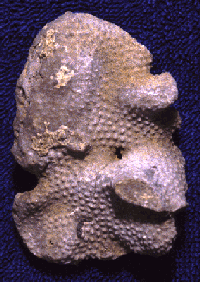


| Bryozoa are aquatic colonial animals, which are abundant in modern marine environments, and have been important components of the fossil record. In places, the skeletal remains are so abundant that the fossils become an important rock-forming material. If you need a common name, then you can call them “sea mats”, “moss animals” or “lace corals” for some forms. These common names come the appearance each type of bryozoa have. The majority of bryozoans are marine, although brackish-water and freshwater forms are moderately common. Bryozoans, those sometimes referred to as Entoprocta and Ectoprocta, live in colonial structures that are much larger than the individual animal. Because these structures are usually composed of secreted calcite, they commonly form fossils. | |
 |
The word “colonial” can explain more about bryozoan life. It is applied to types of animals which reproduce, among other ways, by budding new parts asexually from the original animal. These new additions contain functioning individuals, capable of feeding independently, yet remaining attached to the rest of the animal. Colonial animals include corals and hydroids, ascidians, graptolites and pterobranchs, as well as bryozoans. The entire complex is called a “colony”; the individual funcional units can be called “zooids”, although “polyp” is used for coral individuals, and “theca” in the case of graptolites. Additionally, there is debate about coloniality in sponges. Bryozoan colonies have a superficial similarity with corals, but the anatomy of the bryozoan animal is much more complex. To learn more about corals, or sponges, just click on the appropriate icons below. |
|
Corals
|
|
| Bryozoan fossils occur in many forms, including finger-shaped, fan-shaped, mats, spiraling fans, and massive irregular mounds. Many of the fossils, if examined closely with a magnifying glass, will show the individual pits where the individual bryozoans lived. Each animal was attached to the inside of its pit and could not leave the pit. Bryozoa feed on microscopic organisms floating in the water, which they grab with tiny tentacles. | |
| Mississippian fenestrate bryozoan colony, called Archimedes, lived attached to a screw-shaped support structure. An example of an Archimedes is shown here. In this figure, only the structure is readily seen. The edge view of several lace-work sheets of the colony can barely be discerned extending laterally from the supports. In life, this support would have been upright and attached to the sea bottom or a shell of some sort. |  |
|
|
|
|
|
|
